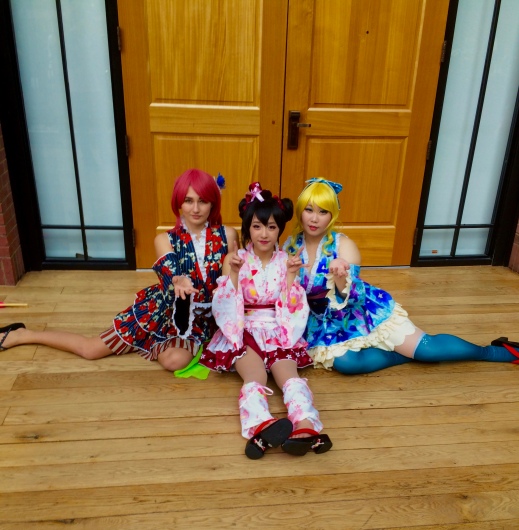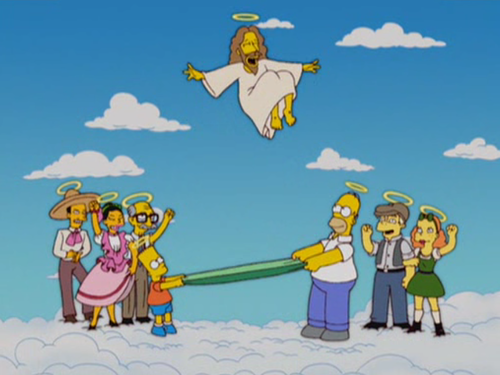
Random participants at the 2016 Katsucon Convention.
So my 15-year-old girl had a lot of fun this Saturday. Her dream came true when we pulled up to the Gaylord Hotel outside of Washington, DC, for her first anime convention. She had been preparing for this for months, figuring out who she should dress as and then fretting over every little detail of her cosplay costume.
Of course, she didn’t go alone. Dutiful dad that I am, I joined her. I had checked out the group’s website, and found the dress code, which included such rules as “At least one inch of fabric over the nipples” and “All play weaponry must be concealed when you are outside the convention center.” I also saw that there were a number of panel discussions, ranging from “How to Sew Your Own Plush” to the late-night, age-restricted “Introduction to Japanese Bondage Techniques”—complete with demonstrations. Well, okay, then!
Anyway, from the moment we entered the convention hall, we were surrounded by people of all ages, shapes, sizes, colors, and gender configurations. Almost all of them were dressed as their favorite character from anime or sci-fi or fantasy or just about anything else. There were Pokémon, elves, storm troopers, satyrs, Halo soldiers, flying monkeys, creepers, and Splatoon squids. And many, many others. More than 15,000 of them. I was one of the few who hadn’t dressed up—just jeans, sneakers, and a sweatshirt. I guess I could have said I was going as Awkward Suburban Dad, but I would have needed some identifying totem, like a DirecTV remote or a Black & Decker power tool to make the costume believable.

My girl, the Splatoon Inkling.
I didn’t know what my girl would want to do there for six whole hours. None of the panel discussions interested her, and the exhibit hall wasn’t all that big. But it turns out I didn’t have to worry. She knew exactly what she wanted to do. Apart from a half-hour in the exhibit hall, we spent most of the time wandering around the convention center and the hotel’s public spaces. She was so very excited to see everyone’s costumes, and she took pictures. Lots and lots of pictures. Her wandering wasn’t calculated, but it didn’t matter. We went here, then there, then back here, then over there, then back again. All the while, she kept cooing about how happy she was to be there.
Work the Crowd.
Then she got an idea, which she picked up from observing some veteran cosplayers. She found a spot in an open area in the busy hotel lobby and just stood there waiting for people to come and take her picture. It was quite a sight: she in her very simple, decidedly amateur, costume, flanked by a portly Japanese princess on one side and a svelte, leather-clad female vampire on the other.
I stood about 25 feet away so that I could keep a watchful eye on her but give her some freedom. Over the next hour, hundreds of people walked past, most of whom didn’t pay her any attention. A few people stopped to take her picture, and a couple of folks talked with her for a bit—including one young man from France whose friendliness prompted me to hover more closely. But overall, I was happy. “This is so good!” I thought. “My little girl is getting out there; she’s spreading her wings, taking risks, and enjoying it.”

Not too close to my daughter, Frenchie!
From there, we moved to a different location, where she stood for another 90 minutes. Only this time, she didn’t just stand there. She began waving her gun in front of her, occasionally “shooting” at some of the passersby. She looked like a slo-mo version of those people who stand on the street corner twirling an advertising sign. And that worked a lot better. Not only did she get many more requests for pictures, but she also got other characters to interact with her—the Halo soldiers, for instance, shot back at her.
So my girl had a good day. So good, in fact, that she’s already planning her outfit for a similar gathering in August. I think Katie’s going to take that one, though. Once a year is enough for me!
Taking It in Stride.
So what did I think of the whole thing? It was eye-opening. I spent my Saturday surrounded by people with a passion for a subject that was almost completely foreign to me. It took a little getting used to—seeing grown men and women dressed up so exotically and play-acting as cartoon characters.
Looking around at all the elaborate, ultrageeky costumes, I was brought back to my earlier years, when I would have dismissed this whole thing as just a bunch of maladjusted, self-indulgent nerds lost in a synthetic fantasy world. “Get a life!” I would have said under my breath. And I most certainly would not have allowed my children to get involved in such arcane doings. But then I went ahead and had actual, real life kids. Kids with autism. Kids with different brains and different neurologies than mine. And as a result I have learned to take a load of supposed weirdness in stride. So no, it wasn’t all that odd for me. In fact, after the initial adjustment, it felt completely normal.

“Don’t mind us. We’re just sitting on the floor of this hotel lobby being fabulous.”
One of Us.
One brief scene from the day cemented this for me, and it’s an image that I suspect will stay with me for a long, long time. During our wanderings, I caught sight of one fellow who looked like he was in his early twenties. He stood out in part because he wasn’t dressed up as anything—just jeans and a tee shirt. He was on the up escalator, and he was holding a plush Pokémon. All the way up the escalator, he was nuzzling the thing, smiling broadly at it, and talking excitedly to it. He flapped his hands occasionally and bounced happily on the balls of his feet. He looked so happy, I couldn’t help but smile.
That’s when it hit me. This was not some poor unfortunate soul to be pitied. This was a happy, adjusted man enjoying a day out on the town. He looked healthy and well fed. He had clothes on his back and shoes on his feet. His hair was mussed up but not unkempt. He was in the midst of a huge crowd navigating a virtual rabbit warren of meeting rooms, lobby spaces, and exhibit halls, but he showed no signs of anxiety or disorientation. He was having the time of his life. I realized I was looking at him not as “one of those,” whatever “those” might mean. He wasn’t an “other.” He wasn’t even part of a different tribe. We were both part of the same tribe. But it wasn’t that he had joined my tribe and become “one of us.” Somehow, over the years of watching and learning from my kids, I had joined his tribe.
I was one of his.



 Do you see that plush doll in the crook of her right arm? That’s Phantump, one of her favorite Pokémon characters. She is rarely separated from this creature, and when she is, she’s holding another one of the more than 100 she has collected over the years. They are her security blanket. They bring her comfort. They help her bridge the gap between the fantasy world she so enjoys and the real world, which is fraught with challenges and dangers.
Do you see that plush doll in the crook of her right arm? That’s Phantump, one of her favorite Pokémon characters. She is rarely separated from this creature, and when she is, she’s holding another one of the more than 100 she has collected over the years. They are her security blanket. They bring her comfort. They help her bridge the gap between the fantasy world she so enjoys and the real world, which is fraught with challenges and dangers.




